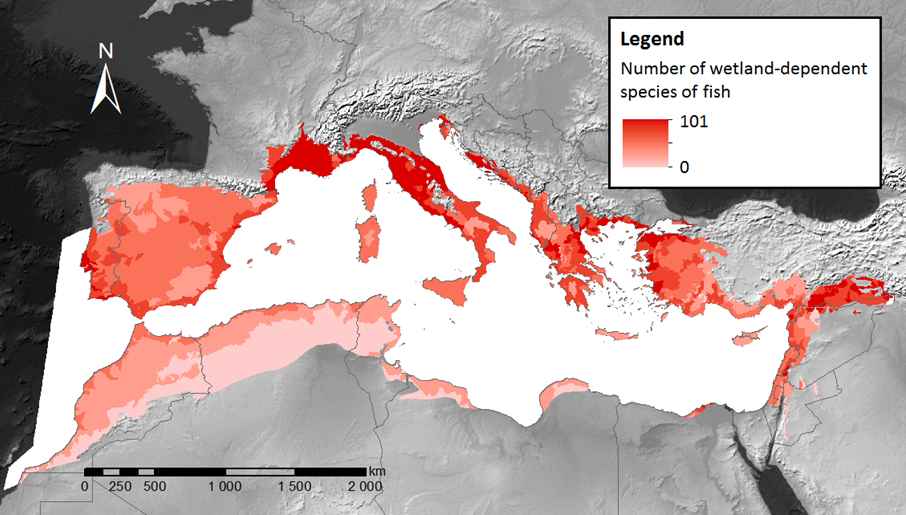Human activities cause wetland degradation and loss by pollution, habitat destruction, and the introduction and subsequent population explosions of non-native species. All this has brought us to a point where the Mediterranean region, according to the International Union for Conservation of Nature (IUCN), risks losing 56% of endemic freshwater fish, 36% of freshwater crabs and crayfish, 29% of amphibians, and 19% of dragonflies during the next decades. Trends in wetland biodiversity are particularly bad in the Eastern Mediterranean (IUCN report: the Mediterranean: a biodiversity hotspot under threat).
Freshwater fishes represent a group of species particularly little known by the wide public in the Mediterranean basin. Mediterranean rivers and lakes are host to 595 species of fish, half of which are endemic (253), sometimes in only one river basin (Source IUCN Med, The status and distribution of freshwater fish endemic to the Mediterranean basin (2006)).
 Fish Species Map of the Mediterranean Basin (MWO ; IUCN Red List)
Fish Species Map of the Mediterranean Basin (MWO ; IUCN Red List)
According to the IUCN Red List, the conservation status of this group of species is of particular concern: 38% of the totals are threatened (CR+ EN+VU). Human activities have already resulted in the permanent extinction of 12 species of fish in the region. Among the identified threats are the alteration of the hydrological functioning of watercourses following the construction of dams and irregular rainfall in a context of climate change, drainage of wetlands, water pollution, and introduction of exotic fish species (source : http://medwet.org/2018/04/world-fish-migration-day-2018/)
A few references for Morocco:
- Agnèse, J.F., Louizi, H., Gilles, A., Berrada Rkhami, O., Benhoussa, A., Qninba, A. and Pariselle, A. 2018. A euryhaline fish, lost in the desert: The unexpected metapopulation structure of Coptodon guineensis (Günther, 1862) in the Sebkha of Imlili. R. Biologies.
- Clavero, M., Qninba, A., Riesco, M., Esquivias, J., Calzada, J. and Delibes, M. 2017a. Fish in Moroccan desert rives: the arid extreme of Mediterranean streams. Fishes in Mediterranean Environments 003: 21 pp.
- Clavero, M., Calzada, J., Esquivias, J., Veríssimo, A., Hermoso, V., Qninba, A. and Delibes, M. 2017b. Nowhere to swim to: climate change and conservation of the relict Dades trout Salmo multipunctata in the High Atlas Mountains, Morocco. Oryx: 1–9.
- Clavero, M., Esquivias, J., Qninba, A., Riesco, M., Calzada, J., Ribeiro, F., Fernández, N. and Delibes, M. 2014. Fish invading deserts: non-native species in arid Moroccan rivers. Aquatic Conservation: Marine and Freshwater Ecosystems.
- Falcón, J.M., Brito, A. and González, G. 2002. Peces de la laguna de Khnifiss (Sahara, NW de África) y de los sectores costeros próximos. Acad. Canar. Cienc. 14: 139–152.
- Maigret, J. 1977. La faune ichtylogique du Banc d’Arguin. In: Richesse Du Parc National Du Banc d’Arguin, 29-38. ASPNBA.
- Qninba, A. and Mataame, A. 2009. Mise au point sur la répartition au Maroc des Cichlidés (Pisces, Perciformes) basée sur les échantillons conservés dans les collections du Muséum national d’Histoire naturelle de l’Institut Scientifique (Rabat, Maroc). Bulletin Institut scientifique Rabat. Sciences de la Vie 31: 57–61.
- Qninba, A., El Agbani, M.A., Radi, M. and Pariselle, A. 2012. Sur la présence de Tilapia guineensis (Teleostei, Cichlidae) dans les gueltas d’un affluent de l’Oued Chbeyka, l’Oued Aabar (Province de Tan Tan, Sud-ouest du Maroc). Bulletin Institut scientifique Rabat. Sciences de la Vie 34 (2): 125–126.
- Qninba, A., Laamiri, M.B., Amhaouch, Z., Rihane, A., Radi, M., Dakki, M. and El Agbani, M.A. 2017. Qu’est-il advenu des poissons d’eau douce déversés dans la retenue du barrage Al Massira-Laâyoune après le fort épisode de crue de l’Oued Saquiat Al Hamra à l’automne 2016 ? Go-South Bulletin 14: 106–110.
